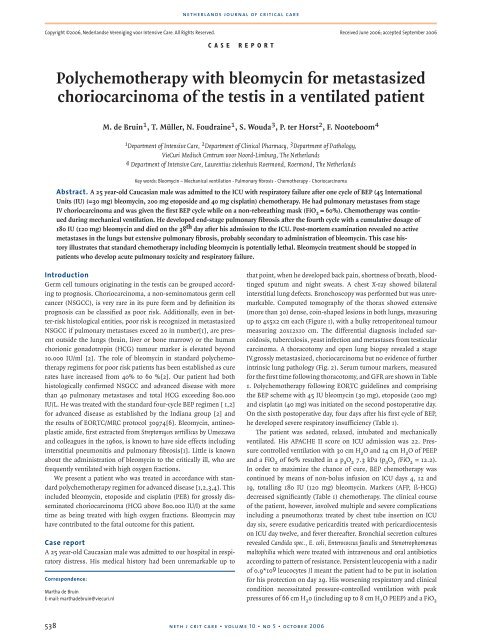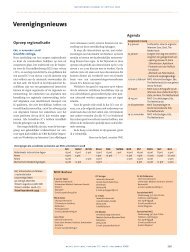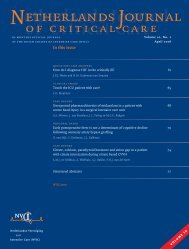Netherlands Journal
NJCC Volume 10, Oktober 2006
NJCC Volume 10, Oktober 2006
- No tags were found...
You also want an ePaper? Increase the reach of your titles
YUMPU automatically turns print PDFs into web optimized ePapers that Google loves.
netherlands journal of critical care<br />
Copyright ©2006, Nederlandse Vereniging voor Intensive Care. All Rights Reserved. Received June 2006; accepted September 2006<br />
c a s e r e p o r t<br />
Polychemotherapy with bleomycin for metastasized<br />
choriocarcinoma of the testis in a ventilated patient<br />
M. de Bruin 1 , T. Müller, N. Foudraine 1 , S. Wouda 3 , P. ter Horst 2 , F. Nooteboom 4<br />
1 Department of Intensive Care, 2 Department of Clinical Pharmacy, 3 Department of Pathology,<br />
VieCuri Medisch Centrum voor Noord-Limburg, The <strong>Netherlands</strong><br />
4 Department of Intensive Care, Laurentius ziekenhuis Roermond, Roermond, The <strong>Netherlands</strong><br />
Key words: Bleomycin – Mechanical ventilation - Pulmonary fibrosis - Chemotherapy - Choriocarcinoma<br />
Abstract. A 25 year-old Caucasian male was admitted to the ICU with respiratory failure after one cycle of BEP (45 International<br />
Units (IU) (=30 mg) bleomycin, 200 mg etoposide and 40 mg cisplatin) chemotherapy. He had pulmonary metastases from stage<br />
IV choriocarcinoma and was given the first BEP cycle while on a non-rebreathing mask (FiO 2 = 60%). Chemotherapy was continued<br />
during mechanical ventilation. He developed end-stage pulmonary fibrosis after the fourth cycle with a cumulative dosage of<br />
180 IU (120 mg) bleomycin and died on the 38 th day after his admission to the ICU. Post-mortem examination revealed no active<br />
metastases in the lungs but extensive pulmonary fibrosis, probably secondary to administration of bleomycin. This case history<br />
illustrates that standard chemotherapy including bleomycin is potentially lethal. Bleomycin treatment should be stopped in<br />
patients who develop acute pulmonary toxicity and respiratory failure.<br />
Introduction<br />
Germ cell tumours originating in the testis can be grouped according<br />
to prognosis. Choriocarcinoma, a non-seminomatous germ cell<br />
cancer (NSGCC), is very rare in its pure form and by definition its<br />
prognosis can be classified as poor risk. Additionally, even in better-risk<br />
histological entities, poor risk is recognized in metastasized<br />
NSGCC if pulmonary metastases exceed 20 in number[1], are present<br />
outside the lungs (brain, liver or bone marrow) or the human<br />
chorionic gonadotropin (HCG) tumour marker is elevated beyond<br />
10.000 IU/ml [2]. The role of bleomycin in standard polychemotherapy<br />
regimens for poor risk patients has been established as cure<br />
rates have increased from 40% to 60 %[2]. Our patient had both<br />
histologically confirmed NSGCC and advanced disease with more<br />
than 40 pulmonary metastases and total HCG exceeding 800.000<br />
IU/L. He was treated with the standard four-cycle BEP regimen [ 1,2]<br />
for advanced disease as established by the Indiana group [2] and<br />
the results of EORTC/MRC protocol 30974[6]. Bleomycin, antineoplastic<br />
amide, first extracted from Streptomyces vertillicus by Umezawa<br />
and colleagues in the 1960s, is known to have side effects including<br />
interstitial pneumonitis and pulmonary fibrosis[1]. Little is known<br />
about the administration of bleomycin to the critically ill, who are<br />
frequently ventilated with high oxygen fractions.<br />
We present a patient who was treated in accordance with standard<br />
polychemotherapy regimen for advanced disease [1,2,3,4]. This<br />
included bleomycin, etoposide and cisplatin (PEB) for grossly disseminated<br />
choriocarcinoma (HCG above 800.000 IU/l) at the same<br />
time as being treated with high oxygen fractions. Bleomycin may<br />
have contributed to the fatal outcome for this patient.<br />
Case report<br />
A 25 year-old Caucasian male was admitted to our hospital in respiratory<br />
distress. His medical history had been unremarkable up to<br />
Correspondence:<br />
Martha de Bruin<br />
E-mail: marthadebruin@viecuri.nl<br />
that point, when he developed back pain, shortness of breath, bloodtinged<br />
sputum and night sweats. A chest X-ray showed bilateral<br />
interstitial lung defects. Bronchoscopy was performed but was unremarkable.<br />
Computed tomography of the thorax showed extensive<br />
(more than 30) dense, coin-shaped lesions in both lungs, measuring<br />
up to 4x5x2 cm each (Figure 1), with a bulky retroperitoneal tumour<br />
measuring 20x12x10 cm. The differential diagnosis included sarcoidosis,<br />
tuberculosis, yeast infection and metastases from testicular<br />
carcinoma. A thoracotomy and open lung biopsy revealed a stage<br />
IV,grossly metastasized, choriocarcinoma but no evidence of further<br />
intrinsic lung pathology (Fig. 2). Serum tumour markers, measured<br />
for the first time following thoracotomy, and GFR are shown in Table<br />
1. Polychemotherapy following EORTC guidelines and comprising<br />
the BEP scheme with 45 IU bleomycin (30 mg), etoposide (200 mg)<br />
and cisplatin (40 mg) was initiated on the second postoperative day.<br />
On the sixth postoperative day, four days after his first cycle of BEP,<br />
he developed severe respiratory insufficiency (Table 1).<br />
The patient was sedated, relaxed, intubated and mechanically<br />
ventilated. His APACHE II score on ICU admission was 22. Pressure<br />
controlled ventilation with 30 cm H 2 O and 14 cm H 2 O of PEEP<br />
and a FiO 2 of 60% resulted in a p a O 2 7.3 kPa (p a O 2 /FiO 2 = 12.2).<br />
In order to maximize the chance of cure, BEP chemotherapy was<br />
continued by means of non-bolus infusion on ICU days 4, 12 and<br />
19, totalling 180 IU (120 mg) bleomycin. Markers (AFP, ß-HCG)<br />
decreased significantly (Table 1) chemotherapy. The clinical course<br />
of the patient, however, involved multiple and severe complications<br />
including a pneumothorax treated by chest tube insertion on ICU<br />
day six, severe exudative pericarditis treated with pericardiocentesis<br />
on ICU day twelve, and fever thereafter. Bronchial secretion cultures<br />
revealed Candida spec., E. coli, Enterococcus faecalis and Stenotrophomonas<br />
maltophilia which were treated with intravenous and oral antibiotics<br />
according to pattern of resistance. Persistent leucopenia with a nadir<br />
of 0.9*10 9 leucocytes /l meant the patient had to be put in isolation<br />
for his protection on day 29. His worsening respiratory and clinical<br />
condition necessitated pressure-controlled ventilation with peak<br />
pressures of 66 cm H 2 0 (including up to 8 cm H 2 O PEEP) and a FiO 2<br />
538 neth j crit care • volume 10 • no 5 • october 2006







